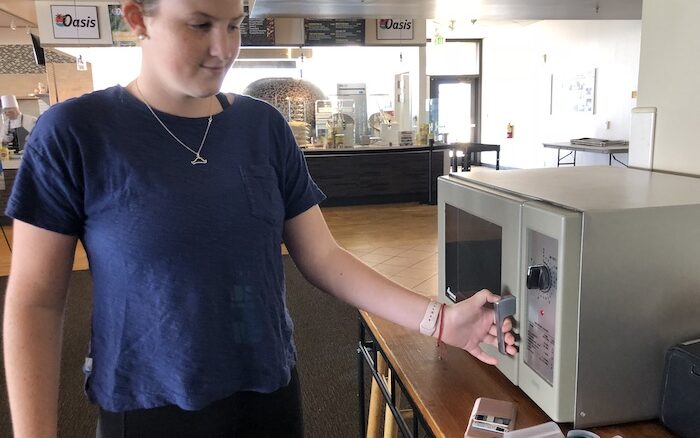
Keto. Paleo. Whole 30. Alkaline. Raw foods. Dukan. Atkins.
Those are just a few of the diets that make up today’s dietary craze.
A Pepp Post poll of 50 students found that 66 percent have dieted in some form. Most students said they dieted to be healthier and to lose weight, following family and friends into fad diets. The danger, certified nutritionist Danielle Gray said, is that most diets offer short-term success only because dieters don’t change their long-term habits.
“I personally don’t like the term diet,” Gray said.
A nutritional shift should be looked at as a lifestyle change and not a diet, Gray said. If people don’t make sustainable changes, their weight will go up and down.
The yo-yo dieter
A yo-yoer dieter is someone whose weight goes up and down because they have not yet figured out why they eat the way they do, Gray said.
“Start with the why, start with the behavior, start with the triggers, start with the emotional reason behind it,” Gray said.
Gray considers diets fads when they are approached as a shortcut. For someone to get get the results they want they must put in the work, there is not a hack. Gray suggested a process of experimenting to find the best way to eat, because not every diet is for every person.
“So just make sure your sources you’re getting your food from are high quality, eat the colors of the rainbow and don’t obsess,” Gray said.
Peer influence versus media influence
The Pepp Post poll found that 28 percent started a diet they learned about on social media. Of these responses, the most popular diet was the Whole 30.
Only 22 percent of students polled said they started a diet just because a friend was trying it.
Yet out of 10 student interviews, eight said they began their diet due to some form of peer pressure. These eight students initially started and were overall more successful with their diets because they heard about it through a family member or friend.
Keto and Atkins
The Keto diet is higher fat, very low carb and moderate protein, according to the Mayo Clinic. The goal of this diet is weight loss. It requires reducing carbohydrate intake and replacing it with fat. Through this switch the body begins to burn fat as energy. Keto also reduces blood sugar and insulin levels, according to Healthline, a health website.
Atkins is similar to Keto in that they both require carb restriction. The diets differ in the amount of alloted daily protein consumption. Atkins has no cap but Keto limits protein to 20 percent of the daily goal. Another key difference is that Atkins eventually allows the reintroduction of carbs and Keto always restricts them, according to Everyday Health, a health newsletter.
Gray believes that this diet can be very effective but cautions people on the reintroduction of carbs.
“When you come off Keto and reintroduce carbs you can get crabby, irritable and feel sluggish,” Gray said. “It just depends if it’s sustainable for you.”
Sam Santana, junior integrated marketing communication major, started Atkins to help her get healthy again after going abroad. Santana started off doing the Keto diet but decided to switch to Atkins due to her family’s history with high cholesterol.
Santana follows this diet pretty strictly, using apps to track what she eats and to count her carbs. In the beginning, Santana said the shift was hard but now it’s become habit.
“I enjoy my diet right now and feel better but I think it’s an easier way that would help you to transition out of this diet into normal and healthier eating habits,” Santana said.
Gray encouraged those on Atkins to stick to whole foods and to shy away from the prepackaged foods the diet offers.
“They have packaged products so you have to be careful about things that are added to that, chemicals, sugars, things like that. It’s better to eat whole foods,” Gray said.
Dukan
The philosophy behind the Dukan diet is resetting your body back to whole foods, said Grace Leister, senior sports medicine major. Leister began the Dukan diet because she wanted to get back in shape and feel more energized. Leister’s mother encouraged her to take up Dukan. Dukan consists of four phases; attack, cruise, consolidation and stabilization phase. Leister said the most challenging part of the diet was the attack phase where she only ate meat, yogurt and cottage cheese for the first six days.
The Dukan diet is good for weight loss, Gray said. The diet calls for low carb and high protein. Gray warns that Dukan should also be paired with increased exercise to compensate for the high amount of protein required.
“Our body can only process about 50 grams of protein at a time so you need to formulate and plan exercise better,” Gray said.
The Whole 30
The Whole 30 diet is 30 days of only eating whole foods. For the duration of the diet, sugar, alcohol, grains, legumes, dairy, carrageenan, MSG, sulfites and packaged foods are not to be consumed, according to the Whole 30 website.
Gray said the Whole 30 is a good experiment to figure out where changes need to be made.
“I personally don’t believe it’s sustainable long term because it’s so restrictive,” Gray said.
Intermittent Fasting
Intermittent fasting does not concern what to eat rather when to eat it. There are three ways to intermittent fast; the 16/8 method, eat-stop-eat and the 5:2 diet. The most popular way is the 16/8 method that requires restricting the daily eating period to an eight-hour window, according to Healthline. The eat-stop-eat method involves fasting for 24 hours once or twice a week. The 5:2 method requires restriction of calories two days of the week and then normal eating for the rest.
Anna Oneto, sophomore mechanical engineering major, began intermittent fasting right after she came back from abroad this summer. Oneto’s father encouraged her to start this diet. Oneto follows her fast pretty strictly and has seen great results from it.
Sophomore economics major Lizzy Kovach also began to intermittent fast this summer. Kovach started the diet with some of her friends from home. Kovach gave up fasting when the school year started but still carries some aspects of the fast with her.
“Going through intermittent fasting I got use to when I was actually hungry versus when I could eat,” Kovach said.
Gray sees no harm in intermittent fasting and thinks it can be quite beneficial as long as the fasting is not for long periods of time.
“Intermittent fasting is fine but fasting for long periods of time can be harmful,” Gray said.
Arbonne
The Arbonne diet consists of products as well as guidelines to health eating. The Arbonne products are a range of detox teas, in-water dissolvables and protein shake mixes. The goal of this diet is weight loss and better health, according to the Arbonne support guide.
Sara Danielson, junior liberal arts major, did a 15-day Arbonne cleanse. Danielson’s mother encouraged her to start Arbonne. Danielson said she did not follow Arbonne too strictly. She had a few cheat days but she still saw results.
Ethical dieting
Caroline King, a junior computer science and business major, is vegan for ethical and sustainability reasons. King chose to turn to veganism for a few reasons; documentaries, family friends and a conversation she had with a teacher abroad.
King, before going vegan, watched “What the Health” and “Forks over Knives.” King also has family friends who suffer from cancer and attributes it to processed red meat. King was ultimately convinced to make the switch to veganism after a conversation she had with her professor, Lausanne Program Director Ezra Plank, while abroad in Switzerland. Throughout this conversation, King and her professor discussed the Bible and sustainability.
“If you look at the Bible it’s saying you have to do good to your body,” King said. “It also tells you how to treat yourself and other people around you but animals are also things that are around you. Ethically it’s not really right to kill a living thing and eat it.”
King further explained the sustainability reasons behind her dietary restriction. She said removing the cow as middleman would be more beneficial for the planet.
“A cow eats the grass but if you just went right to the source and just ate the grass then there would be more food,” she said.
Medical restrictions
Junior IMC major Olivia McDowell, does not diet but suffers from allergies that restrict her eating. McDowell is allergic to seafood and bananas. McDowell said she is indifferent about people who diet for preference.
“You do you,” McDowell said. “They still have reasons and if they find these reasons valid
I’m indifferent for them, good for them.”
Caroline Howard, junior business administration major, has an intolerance to fructose. Howard was diagnosed fructose intolerant in the fourth grade after being misdiagnosed with an ulcer. Howard doesn’t diet but stays away from foods that contain fructose. Howard said she is fine with people who diet for preference but sometimes finds it annoying.
“I think it’s fine if they want to do it to better themselves,” Howard said. “I think it’s annoying though when they say they can’t have something even though it’s a preference. When people act like their allergic to it when it’s actually just a choice.”
Danielle Gray’s recommendation
Gray doesn’t disagree with diets but thinks they should be viewed as the first step in a long-term solution. She recommends finding out what works and what doesn’t. Gray said to eat what makes someone feel their best and not what a diet tells them to eat.
“Thinking realistically and logically about what’s making you feel good and your body perform better,” Gray said.
Madison Daniels completed the reporting for this story under the supervision of Dr. Christina Littlefield and Dr. Theresa de los Santos in Jour 241 in fall 2018. Dr. Littlefield supervised the web story.




